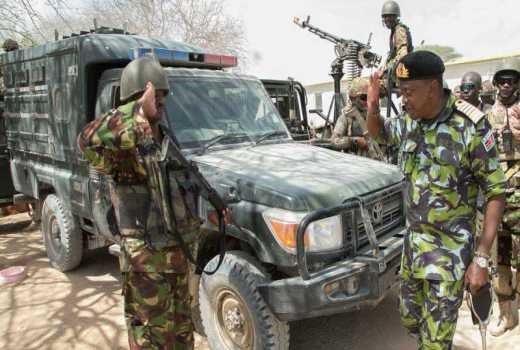
Sunday January 14, 2018

President Uhuru Kenyatta and KDF soldier when he visited their Dhobley camp in Somalia [File| Standard]
We may never know the human or financial cost of the war in Somalia. The Kenyan government, which at the end of 2011 placed its soldiers under the African Union Mission to Somalia (Amisom), has never made public the number of its troops killed or amount of money it has spent on the war.
Key among the numbers which remain a military secret is how many soldiers died in the twin Kulbiyow (2017) and El Adde (2016) attacks. A tally from various media reports show at least 1,000 Kenyans have died since Operation Linda Nchi was launched in 2011 over the abduction of two French tourists
Meanwhile, hundreds of families of soldiers killed in the battle field continue languishing without their key breadwinners, some still awaiting compensation. Military insiders say it costs about Sh7,000 a day to keep a soldier in Somalia. This covers food, transport, medical care, communication and water expenses, which translates to Sh210,000 a month and Sh2.52 million a year.
here are at least 4,000 Kenyan soldiers in Somalia, meaning it would cost Sh10.08 billion a year to keep them in a war that has no end in sight, at least according to President Uhuru Kenyatta. The war has become a hot political potato and one of the key issues in the last two presidential elections.
President Kenyatta, who is serving his second term, has consistently said the Kenyan troops will remain in the war torn nation until the threat level posed by Al Shabaab is brought down. On the flip side, the Opposition insists Kenyan soldiers are better off defending Kenya from within its borders.“The threat remains and therefore we will continue our mission in Somalia,” President Kenyatta said on the campaign trail. “Even as we recognise the sacrifices made so far, we appreciate that this war is not yet won. I urge you all to stand firm in the support of our men and women as we continue our critical mission in Somalia,” he said.
For the Opposition, every attack in Kenya has given them an opportunity to reignite the debate on withdrawing troops from Somalia. None of the Opposition figures has offered an alternative strategy of combating Al Shaabab once the troops are recalled. The Al Shabaab has maintained that the continued stay of KDF in Somalia is the key reason it continues to mount attacks in Kenya. So many have been the Al Shabaab’s attacks on Kenyan soil since 2011 that the police and media stopped keeping track of casualties.
The Westgate, Mpeketoni and Garrisa University College attacks remain the hallmarks of Kenya’s war in Somalia. Sixty eight people died in the Westgate attack in 2013, 148 students at Garissa University massacre in the 2015 and 128 people in the three weeks of terror in Mpeketoni, Lamu County.
“What is clear from the sustained Al Shabaab attacks in Kenya is that they have been significantly weakened inside Somalia and these attacks are meant to scare the Kenyan government through propaganda,” says Patrick Kamau, who teaches International Diplomacy and Peace Studies at the United States International University (USIU).
“Kenya’s greatest problem is that none of the countries who have donated troops to Amisom share a border with Somalia. But then again withdrawing the troops may still expose Kenya to terror and that is the dilemma we are facing,” Kamau says. Amisom soldiers are drawn from Uganda, Burundi, Djibouti, Sierra Leone and Kenya. Kenya joined the Amisom troops in 2012 after a year of going it alone through operation Linda Nchi.
Soldiers allowances Amisom’s funding comes from multiple sources, including AU member states, the AU Peace Fund, the UN Trust Fund for Amisom (and, later, the Somali National Army), the UN Trust Fund for Somali Transitional Security Institutions, UN assessed peacekeeping contributions, and a range of AU/Amisom partners, including the EU.
Soldiers allowances are paid by their governments. The EU then compensates the respective Troop Contributing Countries (TCCs) through Amisom on an annual basis. The funds are only released to Amisom once accounts from the previous payment are signed off.
EU provides $1,028 (Sh102,800) for each Amisom soldier each month. Their respective governments then deduct about $200 (Sh20,000) for administrative costs, meaning the soldiers take home about $800 (Sh82,800). Above this, the TCCs still maintain their soldiers on their payroll when they are in Somalia. An MoU between the African Union and Amisom states that families of killed soldiers are entitled to $50,000 (Sh5 million) compensation.